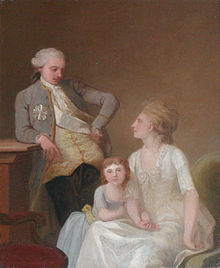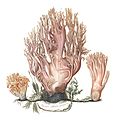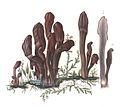Johan Theodor Holmskjold
This article needs additional citations for verification. (February 2013) |
Johan Theodor Holmskiold | |
|---|---|
 Johan Theodor Holmskiold with his family, painting by Jens Juel (1785) | |
| Born | 14 June 1731 |
| Died | 15 February 1793 (aged 61) Copenhagen, Denmark |
| Nationality | Danish |
| Alma mater | |
| Occupation(s) | Administrator, botanist |
Johan Theodor Holmskiold (14 June 1731 – 15 September 1793) was a Danish botanist, courtier and administrator.
Early life and career
Johan Theodor was born 14 June 1731 in Nyborg on the Danish island of Funen as the oldest of eight children to Nicolai Holm and Cathrine Lucie née v. Lengerchen. He first trained with his father who was a surgeon before studying medicine at the University of Copenhagen, graduating in 1760.
During the last three years of his studies, from 1757 to 1769, he toured Europe with professor Friis Rottbøll who paid for his travels. They visited a number of universities in Germany, the Netherlands and France and formed many close bonds with prominent colleagues. In Leiden and Paris Holm collected specimens for a herbarium which was later presented to the King as a gift.
In 1762 he became a professor in medicine and natural history at Sorø Academy. There he founded a botanical garden before leaving the academy with a pension in 1765. At that point he also abandoned his medical career for good, instead turning to various administrative pursuits and his interest in botany.
Successful career in the King's service
In 1767, Holm was appointed director general of the Danish Postal Services in Copenhagen, a position which he held until his death in 1793. From 1772, he also served as cabinet secretary for Dowager Queen Juliana Maria, stepmother of King Christian VII. She held him in high esteem.

Due to his good relations with the royal family, particularly the Queen, he was, in the early 1770s, contacted by Frantz Heinrich Müller, a pharmacist and mineralogist who was setting up a porcelain factory. This led to the foundation of the Royal Danish Porcelain Factory in 1775, with the King as a co-owner, Juliana Maria as a protector and Holmskiold as its first director-in-chief. In 1779, he took full control of the company and remained head of the factory for the rest of his life.[1]
In 1778, he was appointed as one of two directors for a new botanical garden at Charlottenborg. It was created as a joint venture between the University and the King, each of whom was to appoint a director. The first university appointment was Christen Friis Rottbøll, Holmskiold's old teacher and travel companion from his student years, while the King chose Holmskiold.
Holmskiold advanced rapidly through the ranks and was ennobled under the name of Holmskiold in 1781. On the same occasion, he was made a Knight of the Order of the Danneborg and in 1884 was given the title of Gehejmeråd.
Achievements as a naturalist
Beata ruris otia fungis Danicis Impensa
As a botanist, Holmskiold is remembered for Beata ruris otia fungis Danicis Impensa ("Happy Resting Periods in the Country Studying Danish Fungi"), a celebrated two-volume work on fungi. The first volume was not published until 1790, and the second posthumously in 1796, but the work relies on the studies he conducted during the two years he spent in Aarhus after leaving Sorø Academy and prior to his employment with the Danish Postal Services. In Aarhus, Holmskiold had observed and documented the fungi he found and he also commissioned artist Johan Neander to make detailed full-scale drawings of the specimens he collected and described.
Holmskjold's initial engagement with the postal services was most likely a fairly easy task which left him with sufficient time to work on his study of fungi. A first draft, at least of the first volume, was completed as early as 1770. It focussed on Agaricaceae, Clavariaceae and Discomycetes, but Holmskiold was dissatisfied with the book and chose not to publish it at this stage, probably because he got distracted by other pursuits.
Among its 74 described specimens, Beata contains 57 newly named fungi, five new combinations and 52 totally new taxa.[2]
The work received particular appreciation for its renderings, prompting the Swedish botanist Anders Jahan Retzius (1742–1821) to call it "the most brilliant work which had appeared up to that time".[2] He went on to name a genus of flowering shrubs Holmskioldia in Holmskjold's honour. The Harvard University Herbaria describes the illustrations as "stunningly rendered, impeccably accurate, and beautiful illustrations.[2]
-
Illustration of Ramaria Corralloides Purpurea from Beata Ruris Otia Fungis Danicis Impensa
-
Illustration of Peziza Dichroa
-
Illustration of Ramaria farinosa[3]
-
Illustration of Clavaria Mitrata
Other pursuits
In 1776, Holdskjold became a member of the Royal Danish Academy of Sciences and Letters and published several articles in its various journals, including one on catfish which relied on his observations in Lake Sorø during his years at Sorø Academy.
Private life
In 1768, shortly after his appointment as general director of the Postal Services, Holmskiold built a country house on the shore of Lake Bagsværd in Frederiksdal north of Copenhagen. He named it Sophienholm after his fiancée Sophia Magdalena de Schrødersee (1746–1801).[5] They married on 21 December 1770. Holmskjold also acquired five farms in the area.
In 1882, the year after his ennoblement, he commissioned the architect J.B. Guione to build him a new and larger country house on a tract of land at the southern tip of Lake Bagsværd. The building, which became known as Aldershvile, was not completed until 1790. It was a white building with a hipped roof clad in blue-glazed tiles and was surrounded by a 12-hectare English-style landscaped garden with a canal system.[6]
Johan Theodor Holmskiold died on 15 September 1793, not long after the completion of his new home. P.F. Suhm wrote an epitaph in Latin about him. It turned out that he was heavily indebted and that he was guilty of embezzlement against both the Queen, the Postal Services and the Royal Porcelain Factory. The Aldershvile estate was subsequently sold to Adolph Ribbing, a Swedish count who had been exiled for his involvement in the murder of King Gustav III of Sweden.[6]
See also
References
- ^ "Theodor Holmskjolds liv og botaniske arbejde med svampe". Denmarks Naturfredningsforening. Retrieved 2010-09-22.
- ^ a b c "Fungis Danicis". anothermag. Retrieved 2010-09-21.
- ^ "Ramaria farinosa Holmsk. 1781". Mycobank. Retrieved 2010-09-23.
- ^ International Plant Names Index. Holmsk.
- ^ "The History of Sophienholm". Sophienholm. Retrieved 2010-09-21.
- ^ a b "Aldershvile Slotsruin". Danmarks Naturfredningsforening. Retrieved 2010-09-23.
External links
- Properties (in Danish)



![Illustration of Ramaria farinosa[3]](http://upload.wikimedia.org/wikipedia/commons/thumb/b/bd/Beata_Ruris_Otia_Fungis_Danicis_Impensa_3.jpg/120px-Beata_Ruris_Otia_Fungis_Danicis_Impensa_3.jpg)
